James Ignatowich is giving out hot takes like this, instructional videos, and strategy input from other top pros in his weekly coaching newsletter! Click here to subscribe and catch up on previous editions.
-
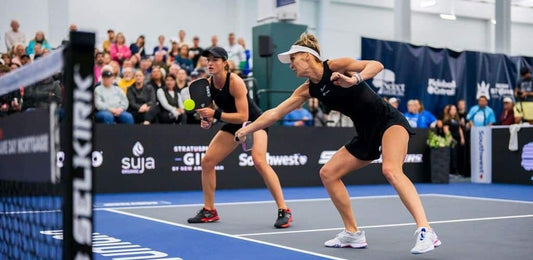
If You're Below 4.5 and Want to Improve in Pickleball, Do This
James Ignatowich says players hoping to go up significantly to levels above 4.5 should follow a tight training regiment, favoring drills over play.
If You're Below 4.5 and Want to Improve in Pickleball, Do This
Top 5 pro James Ignatowich here. Pickleball players at level 4.5 and below should be drilling 60% of the time if they want to continue to improve.
Drilling is more important for 3.0s - 4.5s than it is for 5.0+ players.It’s no secret that what goes on in 5.0+ games is significantly different from 3.5 games in almost every way. Sometimes, it’ll look like two different sports entirely.
In some ways, 3.5 pickleball is more fun. It’s less structured, there’s hardly any dinking, and frankly, you never know what will happen next. However, for these reasons, it’s arguably even more important for 3.5’s to develop a consistent drilling routine.
Since there’s less consistency of point structure in 3.5 games, drilling is the only way to develop that consistency!
- Games at the 5.0+ level typically consist of structured points where players are getting a variety of consistent repetitions hitting dinks, drops, speed ups, and more.
- 3.5 games don’t have that same structure. To break out of the 3.5 level, you need consistent repetitions hitting the same shot over and over, which is what 3.5 gameplay lacks.
For 3.0-4.5 players in general, I would recommend a drill/play ratio of 60/40, in favor of drilling.
This is only for those who are very serious about getting better - I understand that drilling can be “boring”, and that’s ok. If you just want to have fun and play games all of the time, that’s cool too.
For 3.0-4.5’s, the drills don’t need to be complicated. Get a drilling partner and dink back and forth, work on drops with one player up at the kitchen and one at the baseline, and practice volleys, resets, serves and returns.
Read Next: Best Way to Improve Your Pickleball Drive? Slow it Down
While these drills are pretty straightforward there are certainly some best practices to follow in order to get the most out of them.
James Ignatowich says players hoping to go up significantly to levels above 4.5 should follow a tight training regiment, favoring drills over play.
-
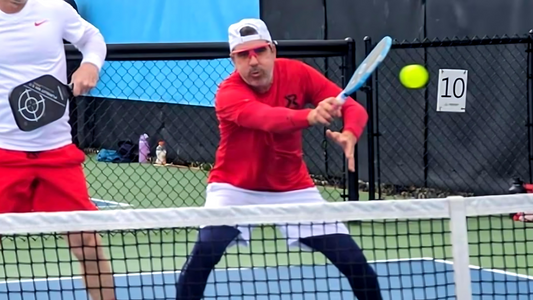
Learning the Strategy Behind Attacking in Pickleball
A scenario for learning about pickleball attack strategy and the decisions made in milliseconds.
Learning the Strategy Behind Attacking in Pickleball
In pickleball, who to attack, when to attack, and where to attack is determined within a 100th of a millisecond. Same for who, when, and where NOT to attack.
Looking for “tells” or clues as to what strategy to take in that split second requires a ton of practice and doesn’t always happen consciously. You’ll learn to pick up on things without knowing you’re actually seeing them.
Very often, you’ll notice multiple cues in an instant that’ll lead you to the highest percentage decision.
Most pickleball amateurs unfortunately go with the popular attack strategy of, “See ball, hit ball…hard!”
Not the most efficient way of executing attacks.
Check out the screenshot of this attack. What do you see that indicates the “X” is probably the highest percentage shot?
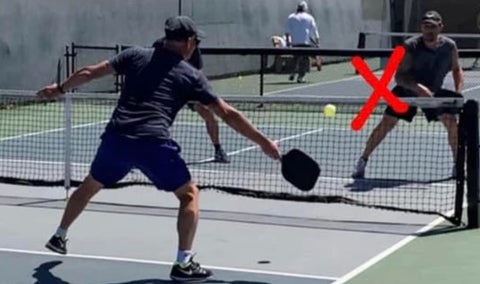
The first thing I noticed was the lean of the attacker. He’s reached enough out wide enough that his left foot has come off the ground - his momentum is ultimately going to fall to the right, leaving him vulnerable to a counter-attack if he doesn’t hit the correct spot.
If I’m the attacker, this is the first clue I feel in my body that’ll help dictate where I initiate.
Secondly, check out the posture of the opponent straight ahead of the attacker.
- He’s anticipating line (because the attacker is leaning wide and reaching). Probably the correct read.
- His weight has already shifted to respond with a BH counter and he’s locked and ready.
- He’s loaded his left leg, leaving minimal weight of his right, and his paddle is in BH, anticipating the counter.
Thirdly, the middle looks open, and maybe it is (if he can roll it perfectly low and in between his two opponents).
The cross court opponent’s left foot is already over the center line, preparing to cover. He might be baiting a middle attack.
If I’m attacking here, I’ll need to see this and before starting this hands battle, in that 100th of a millisecond, want to know three things:
- Does my opponent have a two-handed counter? If he does, I’m not firing this.
- Is he a lefty? If yes, I’m not firing this.
- Can I recover for my re-counter follow up?
My cross court opponent would have to have a weak one handed counter, be a natural resetter, or I’d need to know I can effectively hit a great low roller for me to have confidence in winning this exchange through the center.
Lastly, the attacker needs to have a partner with above average hand speed, because from this ball position and angle of attack, it could easily be countered through him.
I know, I know…reading this and digesting all the possible options is a difficult task. Super difficult, and feels impossible, I get it.
In real time, with a ton of practice, these decisions are made at a speed faster than we can consciously compute.
We begin seeing everything I wrote without even knowing we’re seeing them. Again, though, after we’ve put in hours of work, intentionally rehearsing these types of decisions.
Read Next: An Elite Pickleball Maneuver: the V-Lock
Your biggest and easiest competitive advantage comes from DOING this type of work.
Your opponents, as 98% here, after reading this, will not want to put in this type of effort.
Dayne Gingrich is a Mental Performance Coach. Follow him here.
A scenario for learning about pickleball attack strategy and the decisions made in milliseconds.
-
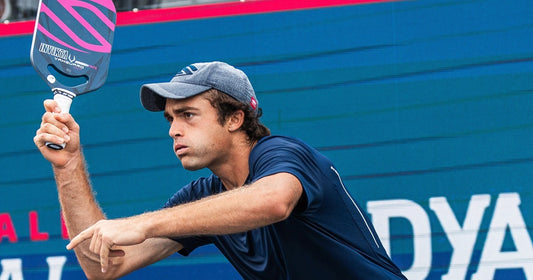
You Should Miss More Pickleball Serves (Here's Why)
If you aren’t missing 1 out of 10 pickleball serves, you aren’t taking enough risk. But the key is how you miss them.
You Should Miss More Pickleball Serves (Here's Why)
Top five pickleball pro James Ignatowich here. There is a risk reward trade-off for anything in life, and the pickleball serve is no exception.
If you aren’t missing 1 out of 10 pickleball serves, you aren’t taking enough risk. But the key is how you miss them. More on that below.
Long gone are the days of the top pros just “laying in” their serves with no intention of creating any offense, or earning “free” points off of missed returns.
Advancements in paddle technology have changed pickleball for good, and the top pros can regularly be seen hitting the serve with power, depth and topspin.
Taking “risk” on the serve, by virtue of hitting the serve with depth and pace, requires some courage.
I would know - I used to be terrified of missing a serve. After all, if you miss a serve, your chances of winning that point immediately go to 0.
You might lose your scoring momentum and your partner may even get mad at you for it. I play mixed doubles exclusively with my girlfriend, so that last factor is very concerning.
So, to make things easier on myself, I would just lay the serve in and get ready to hit a third shot.
Fun fact: I went 9 straight tournaments without missing a serve in 2022. I was congratulated for the streak back then, and I suppose I felt proud of my consistency on the serve. Looking back, it’s nothing to be proud of.
Hitting a hard, deep and aggressive serve has proven to be the superior strategy on the professional circuit.
Successful aggressive serves set you up for success:
- They increase the likelihood of missed returns
- They set up easier third shot drops
- They also give the serving team better set ups for special maneuvers such as the “drive and crash”
This is why I recommend hitting the serve as hard as you can, as long as you make 9/10 of them.
If you can hit the serve very hard and earn some missed returns, I’d argue that making “only” 80% of your serves is your target.
After going over all of my professional doubles matches in 2024, I’ve actually earned MORE missed returns than serves that I’ve missed. That math alone tells me I’m doing something right.
Read Next: No, You Shouldn't RUSH to the Kitchen in Pickleball
If we consider the easier third shots I receive as a result of short returns, it’s a clear home run.
Remember: if you're going to miss, miss wide or deep. Nobody wants to see a netted serve.
James Ignatowich is giving out hot takes like this, instructional videos, and strategy input from other top pros in his weekly coaching newsletter! Click here to subscribe and catch up on previous editions.
If you aren’t missing 1 out of 10 pickleball serves, you aren’t taking enough risk. But the key is how you miss them.
-
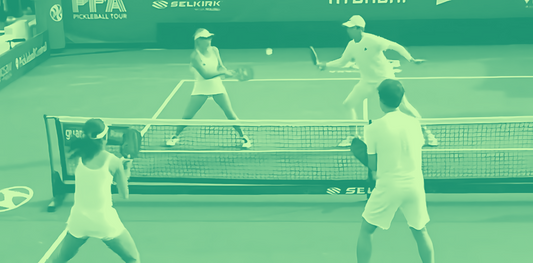
An Elite Pickleball Maneuver: the V-Lock
How close can you pinch the center line to counter a middle attack, but still cover the cross court dink? Get to know this spot...
An Elite Pickleball Maneuver: the V-Lock
The 'V-Lock' is a critical part of ALW & Ben John's success.
It’s a forehand-in-the-middle thing. For you lefties, reverse everything, but the following still applies.
In the video above, Ben isn’t just isolating his opponent Anna Bright -- he and ALW are locking her in a corner with their “V” positioning, forcing her to decide which poison to drink:
- Does she want to get into a dinking war against the best backhand dink in the game?
- Dink straight ahead to ALW and deal with her speed-up?
- Attack the middle through ALW’s and Ben’s best counter-attack?
All options suck!
Look at the screenshots below and check out how Ben forced her into her worst option (speeding up through the middle).
Look at his position - he’s squeezing middle, but not so much that he leaves AB’s cross court backhand dink (her best shot) wide open, but JUST ENOUGH to bait her into attacking through an area that he has locked down with his forehand.
Your positioning here may not be exactly the same, but it’s super important that you know where your “squeeze spot” is.
How close can you pinch the center line to counter a middle attack, but still cover the cross court dink? Know this spot on the court - it’s hugely important to create this V lockdown.
Once the hands battle begins, Ben (forehand middle) squeezes center even harder.
Why? Because he knows the ball has to travel through the middle of the net at some angle.
Very rarely during a hands exchange will the ball get hit through a tiny short angle. Middle forehands, squeeze the center hard (straddle the middle, if necessary) once the firefight begins.
This court positioning is absolute perfection from both ALW and Ben, and it's why they dominate together.
It’s a simple geometry game, kids.
Read Next: Avoid This Common Mistake While Covering the Middle in Pickleball
Know the angles and learn how to cover them, while simultaneously, leaving your ego on the bench.
Dayne Gingrich is a Mental Performance Coach. Follow him here.
How close can you pinch the center line to counter a middle attack, but still cover the cross court dink? Get to know this spot...
INSTRUCTION
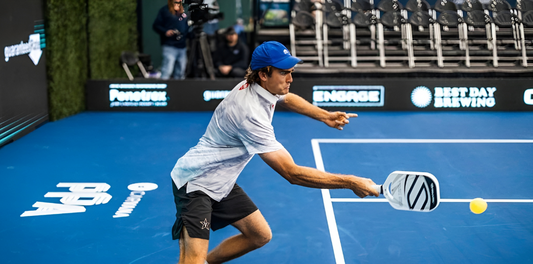
Best Way to Improve Your Pickleball Drive? Slow it Down
James Ignatowich, top pickleball pro, says players seeking to improve their drive should dial their speed down to around 70%.
Best Way to Improve Your Pickleball Drive? Slow it Down
Top five pickleball pro James Ignatowich here. And I'm here to say: you should hit your drives at only 70% power.
Hitting a 70% pace drive is more effective than “going for broke” on the drive. You shouldn’t be trying to hit it as hard as you can.
I used to hit every drive almost as hard as I could. Some of them would go out while others would get “saved” by my opponent hitting them.
As I went up in level, most of my drives wouldn’t really be that effective.
Why Slightly Less Powerful Drives Work
If you’re a 3.0 - 3.5 and you’re able to hit a drive with a lot of power, by all means - do it. On the other hand, if you’re playing against higher level competition, the sheer power of your drive is probably NOT going to be difficult for them to react to.
After all, drives are typically hit from well behind the kitchen line. Rarely will you surprise a higher level player with the pace of your drive.
To the contrary, I’ve had significantly more success hitting drives at 70% of my full power, or even less.
- I’ll aim these drives to land at around 5 feet past the kitchen line. Or, almost directly in between the kitchen line and the baseline.
- If you ever miss a drive deep, your head is not in the right place - or you missed your target by about 10 feet. Let’s just go with “your head wasn’t in the right place.”
- The best drive is designed to hit your opponent in between the ground and the height of their knees, as they are on their way forward after a return.
This drive will force the opponent to “hit up” on the ball. As a result, a drive that is low and dipping at 70% power is much more “crashable,” meaning your partner can poach off of it more easily.
Additionally, since this drive is slightly slower, it gives your partner more time to track and read how to successfully poach off of it.
By contrast, a full power drive will often move too quickly for your partner to get a good read on the crashing potential of it.
Working on your backhand drive? Here's everything you need to know.
A hard drive will also likely meet your opponent above their hip height. I’ll ask you this question - do you feel more comfortable hitting a 4th shot volley from your ankles or above your hips? The answer is above your hips.
So to recap: a 70% pace, low, topspin drive is more effective than a near 100% pace drive because
1) it gives your partner a better opportunity to effectively poach off of it
2) there’s less risk of missing long
3) it will force your opponent to “hit up” on their 4th, drastically increasing the probability that they “pop the ball up.”
James Ignatowich is giving out hot takes like this, instructional videos, and strategy input from other top pros in his weekly coaching newsletter! Click here to subscribe and catch up on previous editions.
James Ignatowich, top pickleball pro, says players seeking to improve their drive should dial their speed down to around 70%.
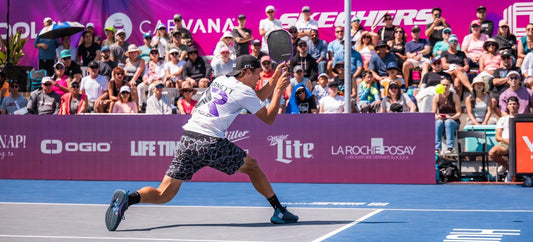
Twoey Secrets: Mastering the Two Handed Backhand in Pickleball
We provide critical tips for improving your two handed backhand drive, focusing on the mechanics of what makes the shot successful and strategic.
Twoey Secrets: Mastering the Two Handed Backhand in Pickleball
The two handed backhand in pickleball – otherwise known as the “twoey” – is in the spotlight this year.
This power-focused shot has gained popularity with some of the top players, and recreational players are taking notice.
Anna Leigh Waters developed it as one of her signature shots, and even Ben Johns is known to bring it out when he’s not playing cat and mouse at the kitchen line.
We spoke with one of the top pros who is especially gifted with a strong twoey, Connor Garnett, who gave us some insight into when and how to pull off this intimidating shot.
What is the Twoey?
“Isn’t it just putting an extra hand on and ripping a backhand?”
Absolutely not.
Generally, the keys to a successful two handed backhand include:
1) Strong left hand involvement
2) A compact swing
3) Utilizing the kinetic chain (more on all of this below)
The technique won’t change much, but there are five main use cases for the twoey which each involve some important differentiations and strategies:
- The down-the-line backhand
- The backhand cross-court
- The transition backhand
- The backhand dink
- The backhand speedup (volley)
Connor breaks down each of those scenarios here:
Before we expand on when and how to use the two handed pickleball backhand, we should also explain the basics of its proper grip.
Finding the Two Handed Backhand Pickleball Grip
If you’re unclear about how to grip the paddle while performing the twoey, practice this set up:
Step one: Hold the paddle face with your non-dominant hand, keeping it out in front of you with the handle facing you.
Step two: Using your dominant hand, reach out and “shake hands” with the paddle’s handle, gripping it as you would when introducing yourself to someone or closing a deal.
Step three: Take your non-dominant hand and place it right behind the first hand. It’s ok if your non-dominant hand has to touch the lower part of the paddle face in order to fit. Extend your pointer finger against the face of the paddle to provide support.
The result should look like this:

Perfecting the Twoey
Strong left hand involvement - The left hand is probably the most important aspect of the twoey backhand, Connor tells us.
“You will see some players working on hitting lefty to build that strength. Make sure that your right hand is along for the ride, but the left hand does the bulk of the work.”
Start by dipping the paddle tip to gain spin and throw the left (non-dominant) hand across, which will naturally finish across the body.
Related: Avoid This Common Mistake While Covering the Middle in Pickleball
“I will put my left pointer finger on the back face of the paddle to get additional feel and allow me to come around the ball,” Connor says.
“This allows me to even generate some side spin through this when dinking.”
Compact swing - With the non-dominant hand on the paddle, you’ll naturally swing shorter than what we see on the forehand.
It is key to ensure that once your right shoulder (inverse for a lefty) hits your chin, the backswing is big enough.
Utilizing the Kinetic Chain - “I have seen people at clinics overuse the arms for power,” Connor warns.
“However, until the hips bring the paddle out on contact, my upper body is still – THEN I will add a swing with the arms to get topspin and add additional torque.”
This technique employs the larger muscle groups (i.e. legs, hips, and core) for the bulk of the power and the smaller ones for the finish and spin. It’ll take some practice, but focus on those two groups as separate entities.
When to Use: The Strategy Behind Two-Handed Backhands
There are numerous instances where the two handed pickleball backhand can give players an advantage.
Right-handers on the left side: you just know your opponent across from you is eventually going to try to speed up on your left-side line. It’s inevitable, so counter it effectively with the twoey.
If you’d have to stretch your arm out to reach a one-handed backhand shot, it’s better to throw that second hand on there to add stability and power. Make them pay for trying the speedup in the first place.
Right handers on the right side: your opponent dinks out wide to your right; you return, and they speed it up through the middle to try to find the gap between you and your partner.
The twoey works here for the same reason it works above. You’re already out of place to some extent, so you want to regain power and form to punish your opponent’s attempt.
Of course, if you’re left-handed, flip these scenarios.
No matter which hand you favor, recognize that the two handed pickleball backhand is all about adding power, stability, and reinforcement.
Ideally, these shots should be reserved for situations where you’re trying to confidently end the point or take your opponent by surprise – but we all know it doesn’t always work out that way…
…Which leads us to our final tip: don’t get cocky.
It’s easy to assume that the extra power your other hand affords you will guarantee the end of a point. But even lower-level players get lucky sometimes and return a hard drive. Be sure to keep the form punchy and snap back into ready position immediately after a short follow-through late in the stroke.
You can follow Connor Garnett on Instagram for more tips.
We provide critical tips for improving your two handed backhand drive, focusing on the mechanics of what makes the shot successful and strategic.
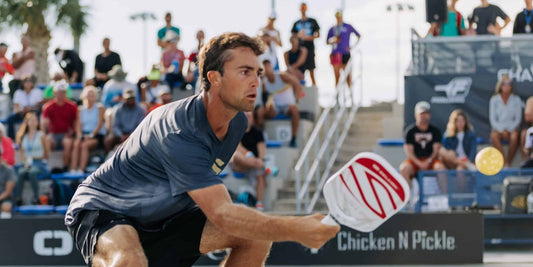
Instantly Improve Your Pickleball Dink Technique with One Tip
In pickleball, you should not use your wrist if you don’t have to. You can instantly improve your dinking technique (and your volley technique) if...
Instantly Improve Your Pickleball Dink Technique with One Tip
Top 5 pro James Ignatowich here. Have you ever wondered why recreational pickleball players consistently have 1) bigger swings and 2) more funky wrist movement involved in their strokes?
I was just teaching a group of 4.0s - 4.5s that I won’t name (to save them the embarrassment of this callout), but let’s just call them “The Big Swing group.”
Or, the “BS group,” for short.
So, for whatever reason, this BS group was taking monstrous swings on all of their dinks and adding unnecessary, funky wrist movement to half of their shots.
One guy was even lifting his left knee up every time he hit a forehand speed up, a move he called, “The Flamingo.” For the record, I told him to stop right away.
I said that if anyone ever asked him where he learned that “move,” he didn’t dare tell anyone that he learned it from me.
I was utterly shocked at the “BS group” because it was almost as if they relished in the silliness of their unnecessarily large swings and funky movements.
I didn’t want to stop them from having fun, so I simply asked them a question:
“Have you ever observed the swings of the top pros, whether it be in a hands battle, dinking, or even a drop or drive?”
Turns out, they didn’t watch pro pickleball. That was the least shocking thing I learned about this group.
My purpose in explaining this story is twofold:
- First, you should watch pro pickleball. That’s the easiest way to gain an understanding of the technique that they use.
- Second, simplicity is key. It’s no coincidence that the top pros have smaller swings than you do. My swings seem to shrink every year. In recently watching myself play a match from 2 years ago, I was surprised to see how big my swings were, and how much extra wrist movement there was.
Decreasing Your Swing Size = Better Consistency
So that brings me to rule of thumb number 1: as you go up in pickleball level, you’ll notice that the size of backswings generally get smaller and more compact.
The higher the level, the faster the ball moves.
So, how do we prepare to go up a level in pickleball? Practice shortening your swings (yes, even your volleys!) and simplifying everything.
After all, there’s no need for any extra wrist movement on the soft stuff. Your wrist should be more or less fixed, with almost no movement at all.
This doesn’t mean you should tense up and try to lock it on purpose, but you should not use your wrist if you don’t have to.
So how do we actually practice shortening our swings and minimizing wrist movement?
If you’re struggling with extra movement and swing size on your shots, the next time you get out there and drill, exaggerate the most simple possible motion to still execute the shot.
Any movement that you may not need for execution? Don’t do it.
For the purpose of this exercise, completely exaggerate it. Now, exclusively hit the shot that way for the entire practice. See if your consistency improves.
Read Next: You Should Miss More Pickleball Serves (Here's Why)
After all, what’s more repeatable, a big swing, or a small swing? And that’s what pickleball is at its core - A game where the winner is determined by who makes more balls inside of the lines In conclusion: Exaggerate the simplicity of your strokes.
James Ignatowich is giving out hot takes like this, instructional videos, and strategy input from other top pros in his weekly coaching newsletter! Click here to subscribe and catch up on previous editions.
In pickleball, you should not use your wrist if you don’t have to. You can instantly improve your dinking technique (and your volley technique) if...

You Should Miss More Pickleball Serves (Here's Why)
If you aren’t missing 1 out of 10 pickleball serves, you aren’t taking enough risk. But the key is how you miss them.
You Should Miss More Pickleball Serves (Here's Why)
Top five pickleball pro James Ignatowich here. There is a risk reward trade-off for anything in life, and the pickleball serve is no exception.
If you aren’t missing 1 out of 10 pickleball serves, you aren’t taking enough risk. But the key is how you miss them. More on that below.
Long gone are the days of the top pros just “laying in” their serves with no intention of creating any offense, or earning “free” points off of missed returns.
Advancements in paddle technology have changed pickleball for good, and the top pros can regularly be seen hitting the serve with power, depth and topspin.
Taking “risk” on the serve, by virtue of hitting the serve with depth and pace, requires some courage.
I would know - I used to be terrified of missing a serve. After all, if you miss a serve, your chances of winning that point immediately go to 0.
You might lose your scoring momentum and your partner may even get mad at you for it. I play mixed doubles exclusively with my girlfriend, so that last factor is very concerning.
So, to make things easier on myself, I would just lay the serve in and get ready to hit a third shot.
Fun fact: I went 9 straight tournaments without missing a serve in 2022. I was congratulated for the streak back then, and I suppose I felt proud of my consistency on the serve. Looking back, it’s nothing to be proud of.
Hitting a hard, deep and aggressive serve has proven to be the superior strategy on the professional circuit.
Successful aggressive serves set you up for success:
- They increase the likelihood of missed returns
- They set up easier third shot drops
- They also give the serving team better set ups for special maneuvers such as the “drive and crash”
This is why I recommend hitting the serve as hard as you can, as long as you make 9/10 of them.
If you can hit the serve very hard and earn some missed returns, I’d argue that making “only” 80% of your serves is your target.
After going over all of my professional doubles matches in 2024, I’ve actually earned MORE missed returns than serves that I’ve missed. That math alone tells me I’m doing something right.
Read Next: No, You Shouldn't RUSH to the Kitchen in Pickleball
If we consider the easier third shots I receive as a result of short returns, it’s a clear home run.
Remember: if you're going to miss, miss wide or deep. Nobody wants to see a netted serve.
James Ignatowich is giving out hot takes like this, instructional videos, and strategy input from other top pros in his weekly coaching newsletter! Click here to subscribe and catch up on previous editions.
If you aren’t missing 1 out of 10 pickleball serves, you aren’t taking enough risk. But the key is how you miss them.

An Elite Pickleball Maneuver: the V-Lock
How close can you pinch the center line to counter a middle attack, but still cover the cross court dink? Get to know this spot...
An Elite Pickleball Maneuver: the V-Lock
The 'V-Lock' is a critical part of ALW & Ben John's success.
It’s a forehand-in-the-middle thing. For you lefties, reverse everything, but the following still applies.
In the video above, Ben isn’t just isolating his opponent Anna Bright -- he and ALW are locking her in a corner with their “V” positioning, forcing her to decide which poison to drink:
- Does she want to get into a dinking war against the best backhand dink in the game?
- Dink straight ahead to ALW and deal with her speed-up?
- Attack the middle through ALW’s and Ben’s best counter-attack?
All options suck!
Look at the screenshots below and check out how Ben forced her into her worst option (speeding up through the middle).
Look at his position - he’s squeezing middle, but not so much that he leaves AB’s cross court backhand dink (her best shot) wide open, but JUST ENOUGH to bait her into attacking through an area that he has locked down with his forehand.
Your positioning here may not be exactly the same, but it’s super important that you know where your “squeeze spot” is.
How close can you pinch the center line to counter a middle attack, but still cover the cross court dink? Know this spot on the court - it’s hugely important to create this V lockdown.
Once the hands battle begins, Ben (forehand middle) squeezes center even harder.
Why? Because he knows the ball has to travel through the middle of the net at some angle.
Very rarely during a hands exchange will the ball get hit through a tiny short angle. Middle forehands, squeeze the center hard (straddle the middle, if necessary) once the firefight begins.
This court positioning is absolute perfection from both ALW and Ben, and it's why they dominate together.
It’s a simple geometry game, kids.
Read Next: Avoid This Common Mistake While Covering the Middle in Pickleball
Know the angles and learn how to cover them, while simultaneously, leaving your ego on the bench.
Dayne Gingrich is a Mental Performance Coach. Follow him here.
How close can you pinch the center line to counter a middle attack, but still cover the cross court dink? Get to know this spot...
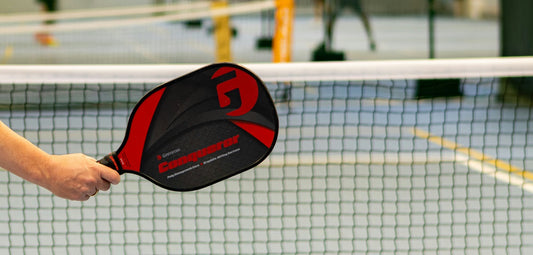
Avoid This Common Mistake While Covering the Middle in Pickleball
An easy smash is floated to your team. So who covers the middle in this situation, sending back the ball for what is hopefully an...
Avoid This Common Mistake While Covering the Middle in Pickleball
Covering the middle in doubles pickleball often leads to an unnecessary mistake that's completely avoidable.
Here's the scenario: we have a long, aggressive player on the left with their forehand (FH) in the middle, trying to make her presence felt. Opponents float a ball in the center for an easy smash, but FH and BH (backhand) collide.
I see this happen quite a bit on the amateur level and sometimes with pros as well.
How do we solve this?
First: as you hear me call to Bonnie up front while her partner returns, I want her squeezing middle on her opponent’s 3rd, even with her BH.
Once they’re both at the kitchen and neutralized, she can slide back into “normal” position and let the long FH pinch middle.
The mistake was made prior to the beginning of the point. What do I mean?
We want to clearly communicate the intention of our roles at the kitchen.
Tracy is super long and aggressive, while Bonnie is shorter and has her BH in the middle (shorter reach, not as much power).
I want them to know exactly what they’re going to be looking for as the point progresses, which includes floaters over the middle.
Now, to the specifics DURING the point.
I loved that Bonnie squeezed her opponent’s 3rd, but after Tracy volleys her 4th... we want Bonnie to slide back right and a couple inches behind the line.
This will allow Tracy to roam aggressively towards middle and get her right foot across the center line for maximum FH pressure.
What’s subtle within this move, but extremely important, is the sliding of Tracy’s right hip.
The foot and hip need to aggressively move to middle, signaling to Bonnie that her FH volley is there.
If she doesn’t do this, Bonnie can’t know Tracy’s there, and will stab for the middle, as well.
Instead of reaching parallel, across the kitchen line, we need Tracy to set her paddle up and reach diagonally THROUGH the kitchen at the floater, cutting off the angle, not letting it drop, and also signaling to Bonnie that she’s there for the smash volley.
Read Next: A Hot Take Re: Pickleball Line Call Etiquette
Sometimes we can yell, “Mine,” etc., but often times, the point happens too fast, so non-verbal communication becomes crucial.
Get that hip and foot in there and make your partner feel your presence.
Embrace your role within the moment.
Dayne Gingrich is a Mental Performance Coach. Follow him here.
An easy smash is floated to your team. So who covers the middle in this situation, sending back the ball for what is hopefully an...
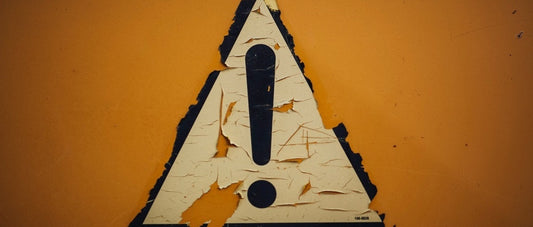
Be Careful Who you Take Pickleball Advice From
As we gain more experience in pickleball, many of us attempt to make it too complicated. Take this story from Coach Dayne as an example.
Be Careful Who you Take Pickleball Advice From
A couple days ago while I was drilling, I looked over at the court next to me because I overheard a player giving his friend some mechanical advice that I disagreed with.
I paused our drilling session to watch and listen for a minute, but not letting them know I was paying attention. The player I was drilling with saw that look in my eye and tried to stop me, but I wouldn’t let him.
I quickly walked to the neighboring court and politely interrupted (I teach on these courts, so I wasn’t a random stranger butting in). I asked to see the shot they were discussing.
After he missed the first two, his friend interrupted and, again, gave him the same technique advice I disagreed with.
I fed the player three more balls, watched carefully, and put this thing to rest.
“It’s not his technique, it’s his intention - he has none. Sure, his mechanics are unique, and his own, but who cares. As long as we can consistently make the ball to (X) spot, we can look any way we want.”
His friend started to fire back (3.5 player, btw), but before he could, I gave the “student” detailed visual intention and fed him ten more balls.
BOOM, 7-10 exactly how he envisioned them.
One of the greatest parts about pickleball is its ability to bring in new players quickly. It’s relatively simple to pick up and become proficient enough to hold a rally with our friends.
As we get more experienced, however, many of us, especially the “rec coaches” or coaches who SHOULDN’T BE coaches, attempt to make it too complicated.
Mechanics don’t drive the bus, they support it. Learn how to properly implement feel and visual techniques that’ll give better cues and instructions to our mechanics.
Read Next: Crossover Backhand Dinks are Your Friend
Before anyone becomes a “certified coach,” please study this piece of the puzzle. And you rec coaches…maybe just PLAY with your friends.
Dayne Gingrich is a Mental Performance Coach. Follow him here.
As we gain more experience in pickleball, many of us attempt to make it too complicated. Take this story from Coach Dayne as an example.
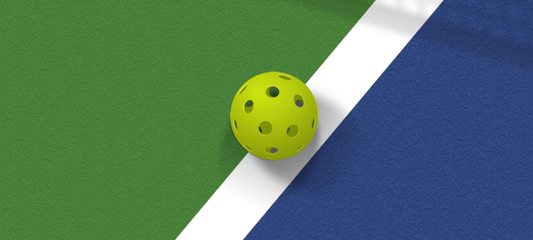
A Hot Take Re: Pickleball Line Call Etiquette
Pickleball line call etiquette tells us we should "just ignore" a bad line call. But trying to do so may hinder your performance in the...
A Hot Take Re: Pickleball Line Call Etiquette
I was recently asked to write about how to respond after a bad line call, as many players unfortunately allow themselves to get mentally flushed down the toilet bowl after a bad call.
*Full transparency: I’ve been known to lose my stuff at specific opponents when I think they’ve made bad calls on purpose. My “justice league” DNA comes to the surface if I believe a player is purposely cheating, rather than accidentally missing their call - we all miss calls.
The cliche advice to players who get overheated after a bad call sounds something like, “Ignore it, don’t worry, move on.”
The traditional pickleball line call etiquette calls for this laissez-faire mindset that the casual side of the game is known for. Only problem is: it doesn't always work.
We can’t pretend the call didn’t happen and there’s no “ignoring” it. Instead, we need a mental place to focus that replaces the emotions we feel from the crappy call.
Also, counterintuitively, I’m a fan of allowing ourselves to be upset and express it to the opponent and referee (if applicable), as long as we mentally shift to our new position of strength before the next point begins.
Tiger Woods gave himself 10 steps to be pissed after a bad shot.
Kobe internally yelled at himself quickly before mentally moving on.
If you feel the need to let out the negativity, do so, BUT…adjust before the next serve is hit.
There isn’t one technique that works for everyone, nor will I pretend to know each possible mental adjustment.
This type of work needs to take place long before you even step on the court, through visualization, meditation, or other internal techniques that help calm the mind.
I personally use what I’ve defined as the “let it out and snap back” technique:
- I’ll let the player know I thought the call was bad (maybe even have a few ’fun’ words back-n-forth)
- When I turn my back and walk to the baseline for the next point, my head drops, eyes close, breathing slows, and I focus on competing THROUGH the emotion
- My personal mantra is, “Next point now! This is why I compete!” I’ll repeat this sentence over and over, until it’s taken the place of the bad line call.
I’m not ignoring the call, I’m acknowledging it, but simultaneously shifting the power struggle from anger to a competitive intention.
However you find your new mental spot, I do suggest purposely turning your back on the situation (figuratively and literally), slowing down your walk and your breath, and intentionally shifting your mind to, “Now what? What do we need to do next?”
Read Next: No, You Shouldn't RUSH to the Kitchen in Pickleball
This will automatically take you to a neutral, more powerful mental place before starting the next point -- traditional pickleball line call etiquette be damned.
Dayne Gingrich is a Mental Performance Coach. Follow him here.
Pickleball line call etiquette tells us we should "just ignore" a bad line call. But trying to do so may hinder your performance in the...
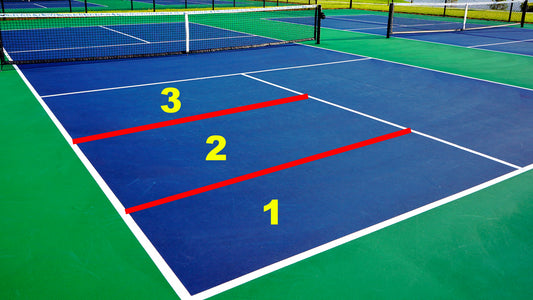
No, You Shouldn't RUSH to the Kitchen in Pickleball
I’ve said it a billion times, so let’s make it a billion and ONE: there’s zero value in rushing to the kitchen line after our 3rd. "WHAT?" I...
No, You Shouldn't RUSH to the Kitchen in Pickleball
I’ve said it a billion times, so let’s make it a billion and ONE: there’s zero value in rushing to the kitchen line after our 3rd.
"WHAT?" I hear you ask. That goes against everything anyone has ever told me about basic pickleball strategy. But the key to my above assertion is in the word rush.
Of course, there will be a couple times here and there where our 3rd drop is perfect, or we take a risk off a ‘crush-n-rush’ drive.
But mostly, we’ll need to move patiently to the kitchen, not rush.
To help with this difficult “rushing” process, I visualize the transition area being broken into three sections.
My goal is to play a ball in each section, unless, again, the 3rd is absolutely perfect.
Check out the image at the top of this article:
Section one: The 3rd ‘hit and assess.’
Maybe we have to hold and reset our 5th because our 3rd was hit too high. This spot allows us the most patience and calm to begin our move forward.
Section two: This is a very dynamic section, because it offers many options.
We can move into this area after a good 3rd, but still have to be weary of a solid opponent rolling it down at our feet off the bounce, so rushing will only get us hurt.
We also may have to remain patient after an OK 5th and prepare for a 7th shot.
My favorite part of section two, however, is the line that connects it to section three. This line is MY target as I move through transition, and should be yours, as well.
If we get our feet on this last line, we’re essentially already “in.”
Read Next: Crossover Backhand Dinks are Your Friend
We wouldn’t be that far through without well-struck resets, so we can comfortably say all that’s left is one last drop and we can literally step to the kitchen line.
Focusing on section three’s line, rather than the kitchen, automatically slows down our transition play and creates more patience through each shot.
If we’re not worried about always having to touch the kitchen line (and hit section three’s line instead), we’ll never rush, making it easier to hold our lower half still through contact, which will result in a more consistent transition play.
Dayne Gingrich is a Mental Performance Coach. Follow him here.
I’ve said it a billion times, so let’s make it a billion and ONE: there’s zero value in rushing to the kitchen line after our 3rd. "WHAT?" I...
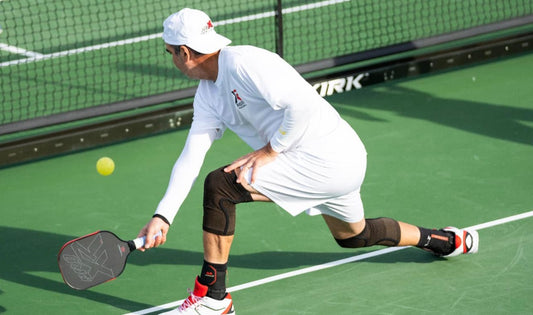
Crossover Backhand Dinks are Your Friend
The most common instance where you should break the “open stance only” rule is when you’re pulled wide on your backhand.
Crossover Backhand Dinks are Your Friend
Ignore coaches and players who tell you to never take a crossover step when you dink. There’s absolutely a correct time to do it, regardless of the level you play.
The most common time where you’ll want to break the old school “open stance only” rule is when you’re pulled wide on your backhand.
Taking a cross-over step will not only save you time and the actual steps you take, but it’ll also help cut off the angle of your opponent’s dink.
Your intention here isn’t to do anything fancy or offensive, it’s simply about getting to the ball on balance and not being pulled off the court.
As you practice this cross-over backhand and get more comfortable with it, you’ll eventually be able to turn it into an offensive angle back to your opponent’s backhand.
Other than the easier footwork, another reason the backhand cross-step approach is valuable and recommended is because your paddle shoulder is on the inside, allowing you to get to the ball earlier.
We can also do this cross-over on a super wide FH dink, but it isn’t as easy, because now your paddle shoulder is on the outside and will force you to come across your body to take the ball earlier - a little bit more difficult to time properly.
Read Next: Our Favorite Paddles for Control
Again, if you get pulled wide, especially on your BH, don’t hesitate to cross-over, cut off your opponent’s angle and make contact as early as possible.
Dayne Gingrich is a Mental Performance Coach. Follow him here.
The most common instance where you should break the “open stance only” rule is when you’re pulled wide on your backhand.


